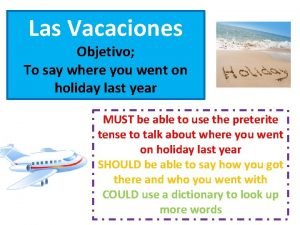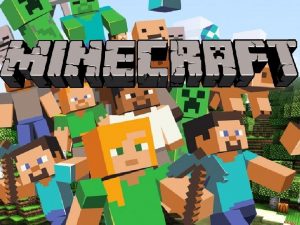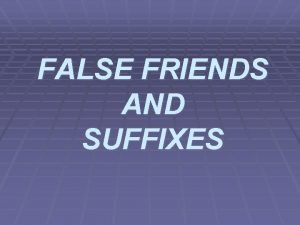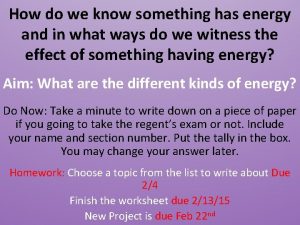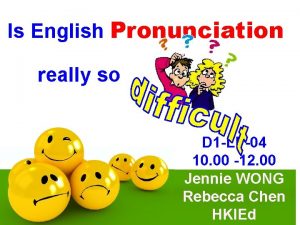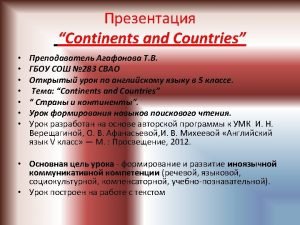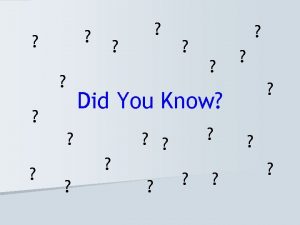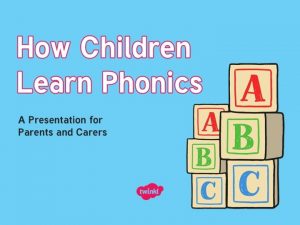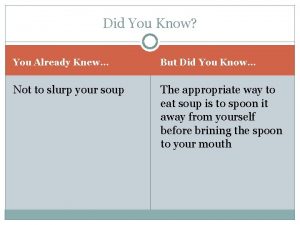Did You Know The English language has 26











- Slides: 11


Did You Know…? The English language has: 26 letters X Y 44 sounds over 100 ways to spell those sounds It is one of the most complex languages to learn to read and spell. Z

The Jargon – A Quick Guide phonics (also known as ‘synthetic phonics’) – The teaching of reading by developing awareness of the sounds in words and the corresponding letters used to represent those sounds. phoneme - Any one of the 44 sounds which make up words in the English language. grapheme – How a phoneme is written down. There can be more than one way to spell a phoneme. For example, the phoneme ‘ay’ is spelt differently in each of the words ‘way’, ‘make’, ‘fail’, ‘great’, ‘sleigh’ and ‘lady’. blending – Putting together the sounds in a word in order to read it, e. g. ‘f – r – o – g, frog’ segmenting – Breaking a word into its constituent sounds in order to spell them, e. g. ‘frog, f – r – o – g’’

What Is Phonics? Phonics is a method for teaching reading and writing. It develops phonemic awareness – the ability to hear, recognise and use the sounds within words. Learners are also taught the correspondence between sounds and the graphemes (spelling patterns) that represent them. Phonics is currently the main way in which children in British primary schools are taught to read in their earliest years. Children will also be taught other skills, such as whole-word recognition (see ‘tricky words’), book skills and a love and enjoyment of reading.

The Importance of Listening Skills Phonics learning relies on children being able to hear and distinguish the sounds within words. Children with poor listening and/or attention skills can struggle with phonics learning. Listening skills begin at birth and there are lots of things that parents and carers can do to support these skills. Children are also taught listening and attention skills during their early years education (age 0 -5). The first phase of formal phonics education (Phase 1) also focuses on key listening skills. Without these skills, children may struggle to master the next stage of their phonics learning.

Phase One Phase 1 has seven aspects, with a focus on listening skills. 1: Environmental sounds 2: Instrumental sounds 3: Body percussion 4: Rhythm and rhyme 5: Alliteration 6: Voice sounds 7: Oral blending and segmenting

Find the Rhymes

Find the Starting Sounds Can you find three things beginning with ‘sss’? How many things begin with ‘h’?

Phase Two In Phase 2, children begin to learn some letter sounds and to match them to graphemes. Most of the first sounds are single-letter sounds but there also several digraphs, where one sound is represented by two letters, e. g. ‘ck’, ‘ll’, ‘ss’. Children also begin to blend the sounds to make words. By the end of Phase 2, children will be able to read some ‘vowel-consonant’ (vc) and ‘consonantvowel-consonant’ (cvc) words, e. g. up, in, cat, pin. Five sets of letters are introduced – one set per week. Children will also learn to read the ‘tricky’ words the, to, go, I, no, which cannot be read phonetically.

Phase Three Phase 3 usually lasts around 12 weeks. Children are taught another 25 graphemes. The final single-letter sounds are taught, together with more consonant digraphs (e. g. zz, qu) and several vowel digraphs (e. g. ai, ee, igh). Children also continue to learn how to blend and segment CVC words using the new sounds, e. g. tail, sheet, night – note that these words still only have three sounds. Children will then move on to blending and segmenting two-syllable words such as cooker, eating, broken. Tricky words also continue to be taught.

 Where did you went
Where did you went Fun fact about tea
Fun fact about tea Worksheet on direct and indirect speech for class 8
Worksheet on direct and indirect speech for class 8 Did you know minecraft
Did you know minecraft Did you know
Did you know Where are you last weekend
Where are you last weekend Suffix of friend
Suffix of friend Have you ever shoplifted
Have you ever shoplifted Friend suffix
Friend suffix How do you know something has energy
How do you know something has energy Pronunciation poem i take it you already know
Pronunciation poem i take it you already know Which countries use british english
Which countries use british english
